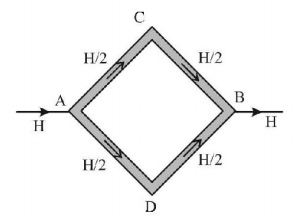Question
Four identical rods of same material are joined end to end to form a square. If the temperature difference between the ends of a diagonal is $${100^ \circ }C,$$ then the temperature difference between the ends of other diagonal will be
Four identical rods of same material are joined end to end to form a square. If the temperature difference between the ends of a diagonal is $${100^ \circ }C,$$ then the temperature difference between the ends of other diagonal will be
(where $$l$$ is the length of each rod)
A.
$${0^ \circ }C$$
B.
$${\frac{{100}}{l}^ \circ }C$$
C.
$${\frac{{100}}{{2l}}^ \circ }C$$
D.
$${100^ \circ }C$$
Answer :
$${0^ \circ }C$$
Solution :
Suppose temperature difference between $$A$$ and $$B$$ is $${100^ \circ }C$$ and $${\theta _A} > {\theta _B}$$

Heat current will flow from $$A$$ to $$B$$ via path $$ACB$$ and $$ADB.$$ Since all the rod are identical,
$$\eqalign{ & {\text{so,}}\,{\left( {\Delta \theta } \right)_{AC}} = {\left( {\Delta \theta } \right)_{AD}}\,\,\left( {{\text{Because heat current}}\,H = \frac{{\Delta \theta }}{R};\,{\text{here}}\,R = {\text{same}}\,{\text{for}}\,{\text{all}}} \right) \cr & \Rightarrow {\theta _A} - {\theta _C} = {\theta _A} - {\theta _D} \Rightarrow {\theta _C} = {\theta _D} \cr} $$
i.e., temperature difference between $$C$$ and $$D$$ will be zero.
Suppose temperature difference between $$A$$ and $$B$$ is $${100^ \circ }C$$ and $${\theta _A} > {\theta _B}$$

Heat current will flow from $$A$$ to $$B$$ via path $$ACB$$ and $$ADB.$$ Since all the rod are identical,
$$\eqalign{ & {\text{so,}}\,{\left( {\Delta \theta } \right)_{AC}} = {\left( {\Delta \theta } \right)_{AD}}\,\,\left( {{\text{Because heat current}}\,H = \frac{{\Delta \theta }}{R};\,{\text{here}}\,R = {\text{same}}\,{\text{for}}\,{\text{all}}} \right) \cr & \Rightarrow {\theta _A} - {\theta _C} = {\theta _A} - {\theta _D} \Rightarrow {\theta _C} = {\theta _D} \cr} $$
i.e., temperature difference between $$C$$ and $$D$$ will be zero.
